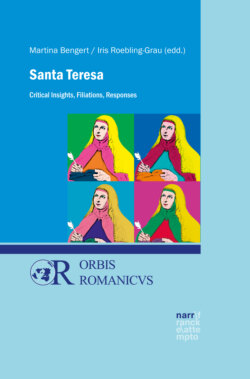Читать книгу Santa Teresa - Группа авторов - Страница 34
На сайте Литреса книга снята с продажи.
Ludolph of Saxony: Vita Cristi
ОглавлениеWith the same certainty with which we can say that Teresa did not know Dürer’s Self-portrait, we can claim that she did know Vita Christi, an extensive retelling of the Gospels composed by Ludolphus, a Carthusian born around 1300. His work was one of her favorite books.1 By having a closer look at this pious writing from the Middle Ages, one discovers both a strong relationship with Teresa’s narration alongside a strong difference.
In the introduction of the Vita Christi, we find the idea of the text as mirror prominently articulated: “Ponte siempre delante este clarísimo espejo de toda santidad: la vida y costumbres del Hijo de Dios y Señor nuestro Jesucristo.”2 This “espejo” as text is located in a long tradition where the ‘speculum’ was a common metaphor for many texts that served as moral instruction for their readers.3 Within this tradition, the idea of presenting a model to the reader that they should imitate is very noticeable. In the Spanish concept of “espejo” the double meaning is still present. The word not only refers to the glass in which one can contemplate one’s own counterfeit but also to the model that wants to be followed. Since in the above quote, the mirror is explicitly clear (stainless), the meaning of the model seems to be obvious. By narrating the life of Jesus Christ, Ludolphus seeks to incite the readers to imitate this life within their own devout way of living: “La lectura de la vida de Cristo debe llevar a imitar a Cristo.”4
Through this noticeable imperative, the readers are addressed as a pious audience in need of guidance. A sense of closeness with them does not appear as central. Yet one might discover this closeness by taking a more detailed look; the aesthetically seducing methods that Dürer and Teresa apply by lending their presentations of Jesus Christ their own appearance do have a place in Ludolph’s text too.
Reading the Vita Christi in view of Teresa’s autobiography, I would like to suggest that the medieval reproduction of the Gospels announces itself as a modern portrait of Jesus Christ, which is to say as a portrait that includes the individual features of a totally human being. This personal aspect becomes visible in the prayers that Ludolph includes in his narration. Traditionally, the narrations of the Gospels did not contain prayers.5 By including this personal voice, grammatically articulated in the first person, in his text, the author narrates more than the contents of the Gospels themselves. He also creates individual access to these contents by including a purely human voice. Even though Ludolphus, displaying humility, does not put his name as the author on the cover,6 the prayers are the passages that refer to him as the person who created this text. Mary Immaculate Bodenstedt stresses the idea that, especially within the prayers, the idea of the conformation with Jesus Christ is central:
The objective of the meditations is not merely to exercise the imagination by recalling some event in the life of Christ, but the reformatio animae. Man is to imitate the divine exemplar and make himself again into the divine image that has been effaced through sin. This idea of conformity to Christ is stressed particularly in the meditations on the passion.7
She therefore calls the prayers the “spirit” of the entire narration.8 These passages have an aesthetic power that exceeds the mere imperative shown above, because they allow the readers to find personal points of contact with this text that otherwise only holds a perfect image of Sanctity up to them. In other words, the prayers invite the readers to find themselves within the narration of a foreign life. They can serve as bases for self-reflection and identification. Since Ludolphus in his time did not have the possibility to ‘narrate Jesus Christ’ through speaking about himself, he had to find another way to render the contents of the Bible approachable.
Teresa as an author of the Early Modern Age could continue this aesthetic innovation. She was able to allow the personal voice of the first person to dominate her entire text. She thereby improved the concept of the text as a mirror for its readers, since not only a foreign model is presented as a reference point for comparison, but a clearly sharpened and fragile human voice calls the public to adhere to the presented contents. Thereby, Teresa continues Ludolphus’ Vita Christi and modifies Augustine’s Confessions. At the same time, what she writes meets the contemporaneous self-portrait that Albrecht Dürer produced around 1500.
Within the context of this book on the reception of Teresa’s work, I would like to suggest that this effort of rendering the contents approachable by creating a ‘mirror-effect’ of a work of art is still powerful in Teresa’s writing today. It might in part be responsible for the broad number of authors, artists, and others who still feel attracted by the unpretentious self-portrait of a woman who lived in a foreign time and under foreign circumstances, but who are nonetheless able to relate to this personal account of mystical experiences in a corresponding personal manner of identification.
